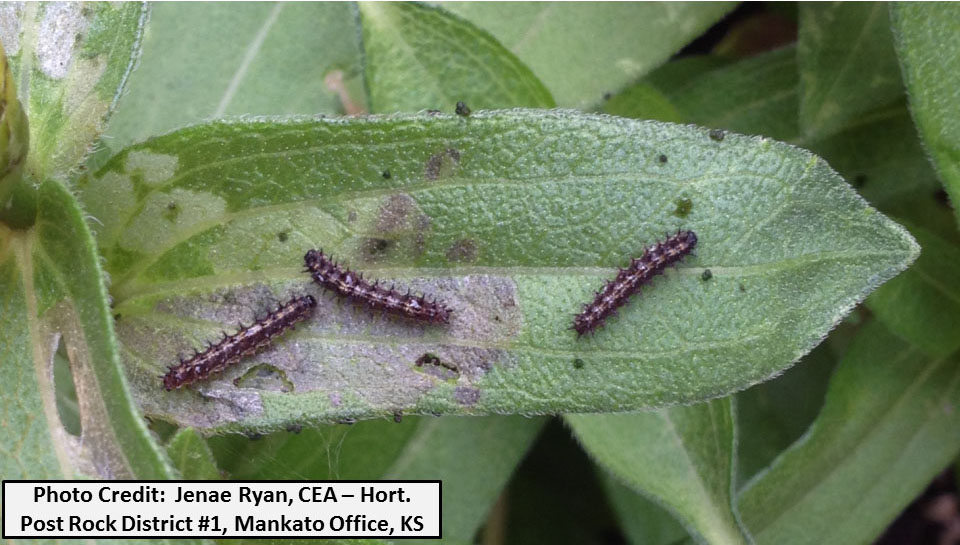–by Bob Bauernfeind
Within the last two weeks, I received e-mails with attached images of caterpillars feeding on various landscape ornamentals. The senders requested identifications of the caterpillar species. Of course, as entomologists, we are expected to come through with positive identifications, as well as recommendations on how to address situations where caterpillars are feeding on prized plants.
Identifying caterpillars can be easy-as-pie for a those species of common occurrence (recently, caterpillars of whitelined sphinx moths, cercropia moths and walnut caterpillar moths), but more difficult for the many many many caterpillars of species encountered on but an infrequent basis. While there are various books with page upon page showing images of butterflies and moths, similar publications picturing the larvae of the same butterflies and moths are limited. The following references would be good additions to one’s book shelf. However, they do not necessarily guarantee accuracy for identifying caterpillars. But at least these references provide a useful starting point when attempting to identify caterpillars.
Four recent submissions were images of rather spiny/bristly looking caterpillars. Almost immediately, one suspects that they likely are caterpillars of butterflies in the taxonomic family Nymphalidae, most of whose caterpillars are adorned with spiny tufts, and rows of branched spines. The collective common name applied to nymphalid butterflies is “brushfoot butterflies” —– so named because (in general) of their hair-covered front legs which are reduced in size, held close to the body, and not used for walking. This largest family of butterflies includes commonly recognized species such as the many that comprise the fritillaries and checkerspots, anglewings (question mark and comma butterflies), thistle butterflies (painted ladies and red admirals), tortoise shells (morning cloak), admirals (white, viceroy and red-spotted purples), milkweed butterflies (commonly, monarchs), hackberry and tawny emperor butterflies, and satyrs and wood nymphs.
Of the most recent inquires, one (an image that I was unable to retrieve) was that of a morning cloak butterfly caterpillar. The accompanying image shows (in detail) the exquisite array of spines and hairs, the dark body with multitudes of small white dots, and the prominent orangish-to-red dorsal patches. Listed hosts include elm, willow, hackberry, poplar, wild rose and Hawthorne.
The next was the unmistakable larva of the dotted checkerspot butterfly. It is always nice when an ID seems to be so clear-cut based on an exact match between the actual specimen and the pictured specimen. Matt McKernan has received numerous reports of these being feeding on Echinacea which includes cone flowers (purple cone flowers being popular garden varieties).
The next 2 examples may be more typical in terms of complicated identifications. Jenae Ryan’s image was of caterpillars on zinnias. Paging through the images in Caterpillars in the Field and Garden, I settled on the only closest match: caterpillars of the Meadow Fritillary.
The complications? The listed host plants were violets, not zinnia. And, Kansas is well outside of the range indicated on the accompanying distribution map.
Mark Ploger submitted this image of caterpillars found on cone flowers.
Assuming that they likely were from the same egg mass, this exemplifies differences in appearances between siblings. As hard as I tried and squinted, there were no matching images in-the-books. So the simple response was, ”Larvae of a Nymphalid butterfly”
The complications? The listed host plants were violets, not zinnia. And, Kansas is well outside of the range indicated on the accompanying distribution map.
The point to be made is that although it is well-and-good to submit actual caterpillar specimens and/or images for identification to satisfy the curiosity of “What is it?”, regardless of knowing their exact identity, if the caterpillars are causing intolerable damage, they need to be eliminated. People have their own levels of tolerance ranging from zero (preferring perfection of plant appearances), to live-and-let-live (preferring to enjoy the beauty of expectant butterflies).






